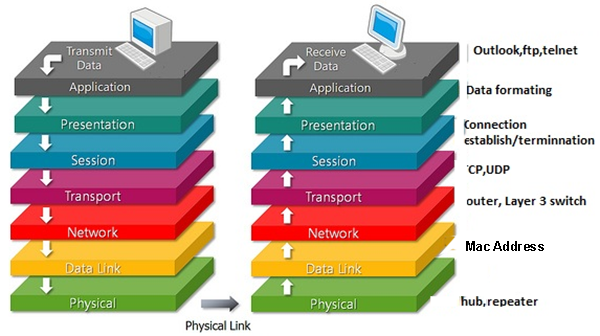The Open Systems Interconnection model (OSI model) is a conceptual model for standardizing data communication functions.
OSI enables inter-operability of different communication systems with standard protocols. The model partitions a communication system into seven layers named:
Application, Presentation, Session, Transport,Network, Data Link, and Physical Layer.

7 layer OSI model Overview
1. Application Layer: Applications
2. Presentation Layer : formatting
3. Session layer : connections management and termination
4. Transport layer : port addressing and error checking, ACK on TCP
5. Network layer : routing and ip addressing.
6. Data link layer : interface between network and physical layer
7. Physical layer : forwarding electrical signal to another end device (hub, repeater).
Examples of OSi 7 layer in Data Communications
Application - FTP, HTTP, HTTPS, SMTP, SSH, Telnet
Presentation - CSS, GIF, HTML, XML, JSON, S/MIME,
Session - RPC, SCP, NFS, PAP
Transport - NBF, TCP, UDP
Network - Pv4, IPv6, ICMP
Data link - IEEE 802.2, PPP, ATM
Physical - DSL, ISDN, USB
more ...
PHYSICAL LAYER
- Transmission and reception of bit stream over a physical medium.
- Describes the electrical/optical, mechanical and functional interfaces to the physical medium
- Data encoding: modifies analog signal pattern to 1s and 0s
- frame synchronization.
- Transmits bits as electrical or optical signals
DATA LINK LAYER
- Provides error-free transfer of data frames from one node to another over the physical layer,
- Link establishment and termination between two nodes.
- Frame traffic control
- Frame sequencing: transmits/receives frames sequentially.
- Detects and recovers from errors that occur in the physical layer.
- Frame error checking: checks received frames for integrity.
- Determines when the node "has the right" to use the physical medium.
NETWORK LAYER
- The network layer controls the operation of the subnet, deciding which physical path the data should take based on network conditions and, priority of service
- Routing frames among networks.
- Subnet traffic control
- Translates logical addresses into physical addresses.
- Subnet usage accounting to produce billing information.
TRANSPORT LAYER
- Ensures that messages are delivered error-free, in sequence, and with no losses or duplication.
- Message segmentation: accepts and splits the message into smaller units and passes to the network layer.
- The transport layer at the destination station reassembles the message.
- Message acknowledgment
- Message traffic control
- Session multiplexing: multiplexes several message streams
SESSION LAYER
- Allows session establishment between processes running on different stations.
- Session establishment, maintenance and termination
- allow processes to communicate over the network, performing security, name recognition, logging, and so on.
PRESENTATION LAYER
- Formats the data to be presented to the application layer.
- This layer translate data to a format used by the application layer from a common format and vice versa.
- Character code translation: for example, ASCII to EBCDIC.
- Data conversion: bit order, CR-CR/LF, integer-floating point, and so on.
- Data compression: reduces the number of bits that need to be transmitted on the network.
- Data encryption: encrypt data for security purposes. For example, password encryption.
APPLICATION LAYER
- Serves as the window for users to access network services.
- Resource sharing and device redirection
- Remote file access
- Remote printer access
- Inter-process communication
- Network management
- Directory services
- Electronic messaging (such as mail)
- Network virtual terminals
 ශිල්ප 64
ශිල්ප 64